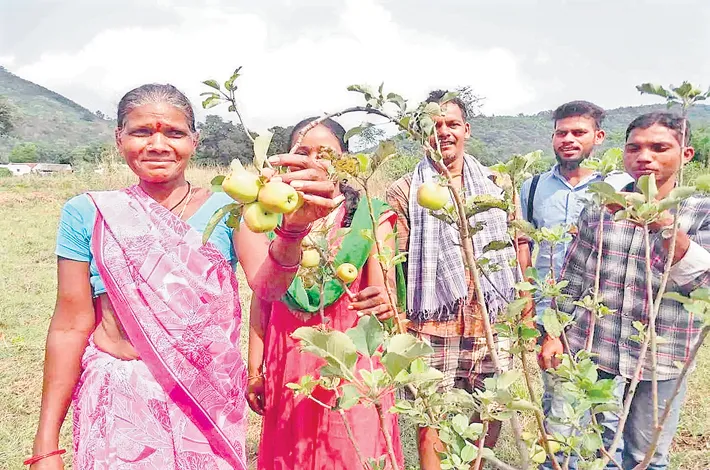himalayan apple finds home in ap
18-11-2025 12:00:00 AM

In Andhra Pradesh’s tribal belt, farmers of Lambasingi, Chintapalli and Araku are steadily turning their cool, misty hills into the South’s own apple country, Kiranmai Tutika reports
kiranmai tutika I hyderabad
For decades, the idea of apple orchards evoked images of Shimla’s icy slopes or Kashmir’s snow-wrapped valleys. But today, a quiet horticultural revolution is unfolding deep within Andhra Pradesh’s tribal belt, where farmers of Lambasingi, Chintapalli and Araku are steadily turning their cool, misty hills into the South’s own apple country. Long celebrated as the state’s strawberry paradise, this high-altitude region is now embracing a new identity, the home of Andhra Apples.
This transformation is no accident. It is the result of coordinated scientific experimentation, sustained fieldwork, and a willingness among tribal farmers to embrace new crops. The game-changer came from Hyderabad’s Centre for Cellular and Molecular Biology (CCMB), which identified striking climatic similarities between the Eastern Ghats of Visakhapatnam Agency and the Himalayan apple-growing regions. With winter temperatures often dipping to zero or even below, scientists concluded that the terrain was naturally primed for apple cultivation.
Following detailed climate studies, CCMB partnered with ITDA Paderu officials and NGOs like Girijana Vikas to introduce apple farming to select tribal villages. Saplings were initially planted in Lambasingi, Kattupalli, Gudem Kothaveedhi and Madem, supported by structured training for farmers. “If everyone grows the same crops, nothing new happens. But if you grow what others can’t, you create value,” trainers told the villagers. The message landed well, and the orchards flourished. Within three years, the first apples began to appear.
“In 2016, we brought Michael and Selection varieties from Shimla and distributed 100 plants each to about 200 farmers. The fruits arrived within two years. While not as sweet as Shimla apples, they are impressive,” recalls Nelluri Satyanarayana, CEO of a tribal development NGO.
Unlike the chemically intensive orchards in the North, the Manyam apples are grown using natural farming techniques. Farmers apply Panchagavya and Jeevamrutham, reducing pest incidence and producing firm, round fruits. “They grow bigger and healthier with natural methods,” says Pusarla Devasahayam of Madem village.
Thanks to abundant spring water flowing year-round from the hills, drip irrigation keeps orchards thriving even in dry months. The region records 260-300 hours of 5°C-10°C temperatures annually, ideal for apple growth. Farmers now harvest twice a year, in December and May, with fruits lasting up to four days post-picking.
Each tribal household typically owns about three acres and grows coffee, pepper and turmeric. Now, with apple orchards added, incomes are rising. “One tree gave 150 fruits this time. Tourists buy them for ten rupees each,” says farmer Robbalingamma.
As apple cultivation expands across the Eastern Ghats, the day may not be far when ‘Manyam Apple’ stands proudly beside Shimla and Kashmir as a brand of its own, grown not in icy North India, but in the cool, whispering hills of Andhra’s tribal heartland.








